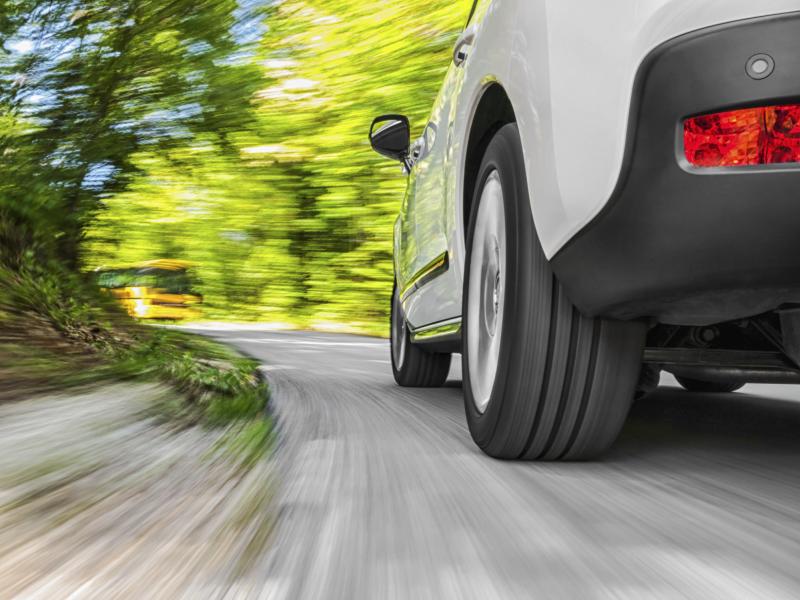
Road noise in tires is the result of three things primarily: the impacts of tire ridges and imperfections against the road, air trapped under the rubber tread blocks decompressing like tiny corks popping from a tiny champagne bottles, and the squeal of rubber gripping the road. Each of these have different causes, but the problem always goes back to the tire itself. So if you want a quieter ride, you're going to need new tires -- that may involve a few compromises on your part, but you might be surprised how small those compromises need to be.
The key to a quiet-riding tire is to avoid compressing air under the tire as much as possible. As tires roll down the road, air gets trapped between the tread blocks and the road. When the air comes out the back and decompresses, it makes a popping sound; if that "pop" happens thousands of times a second, you end up with what sounds like a droning, monotone hum. Off-road tires with big, flat knobs can dig into soft earth like a set of cleats, but those knobs catch and crush air beneath. Tires with large, regularly spaced lateral blocks of tread and few straight, longitudinal grooves around the circumference of the tire will trap air beneath. Avoid tires with large tread blocks separated by just a few, very thick grooves.
For a quiet ride, looking for tires with at least a few grooves all the way around the circumference and lots of small, diagonally oriented water "sipes" connecting them. The small, diagonal channels will allow compressing air to shoot into the longitudinal grooves rather than compress under the rubber. Effectively, in general, the finer and more complex the tread pattern looks, the quieter it will be. You might think that a tire that offers good traction in the rain would be the quietest, then, and that is often the case -- but not always. Air is thinner and faster-moving than water, so giving it room to escape means having loads of tiny, backward-slanted channels throughout the tread, rather than a few larger, more horizontal channels.
For a typical car, you want to look for a Grand Touring, Standard Touring or Passenger all-season tire with a fairly high treadwear rating, good ratings for wet traction and hydroplaning resistance. Tires rated as having low rolling resistance are a good bet also.The same is true for trucks and SUVs, but you're looking for all-season Highway or Touring tires. Again, water and air do act somewhat differently, but a tire that does well channeling water away will tend to do the same with air. Quieter all-season tires will also tend to have higher ratings on ice and in snow, because the same small tread blocks and grooving that help in snow work very well when it comes to not compressing air. Another perk with these tire designs is that they tend to use rubber compounds and construction methods optimized for highway fuel economy, which is something else to look for while shopping.
As of 2014, there are at least a few tires out there which truly excel in the tire noise department without sacrificing traction and performance elsewhere. Among Passenger and Standard Touring All-Season tires, the Continental ProContact with EcoPlus Technology is a popular choice, but the Goodyear Assurance Comfortread and Nokian Entyre are even quieter. Michelin's top-rated Defender isn't quite as quiet as the Goodyear, but it does offer far better performance and treadwear ratings. Among Grand Touring tires, the Bridgestone Ecopia EP422 is quiet, but so is the company's own much stronger performing and longer-lasting Turanza Serenity Plus. Michelin's Primacy MXV4 takes high honors in this category, being the quietest, most versatile and highest performing overall. It's not quite as good as the Turanza on wet roads, but it's just as good on dry roads and better on snow and ice. For high-performance tires that won't break your ears, look into the Kumho Ecsta 4X or Continental's excellent ExtremeContact DWS.
Getting a quieter ride doesn't always come down to the tire choice alone. A tire with low air pressure slaps the ground in a more flat-footed manner, and the rubber tends to squeal and rub; you can hear that much very clearly if you've ever driven on a completely flat tire. So keep your tires properly inflated. Tire noise will also increase with wear because some of the smaller, shallower grooves that allowed air to escape before have been worn away. This wear-induced noise can be a real problem with higher-speed-rated performance tires, which may use a certain number of shallow or half-depth grooves to enhance high-speed stability. There's not much you can do about wear-induced noise, aside from delaying it by regularly checking your air pressure and rotating the tires. Lastly, take some weight out of the vehicle if you can. A heavy vehicle pushes the tire flatter on the bottom, which has about the same effect on noise as underinflation.